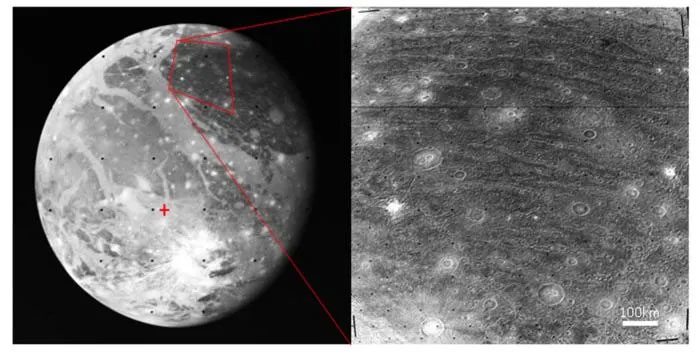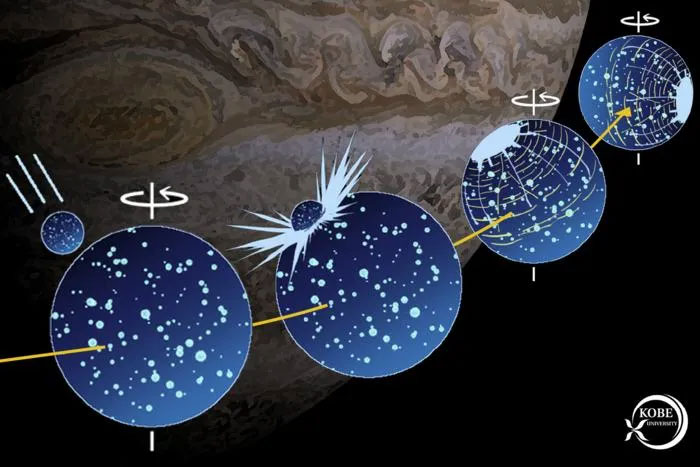An ancient asteroid once collided with and 'flipped' Jupiter's moon Ganymede
The infamous Chicxulub asteroid, which devastated Earth and caused the extinction of the dinosaurs 66 million years ago, is just one of countless meteorites that have struck planets and moons in our solar system over billions of years.
Recently, scientists conducted a study that dug deeper into an even more catastrophic collision in our solar system's distant past: An asteroid 20 times larger than the Chicxulub meteorite caused a planetary-scale disaster four billion years ago, and the unfortunate casualty was Ganymede, Jupiter's largest moon.
Specifically, in a study published on September 3 in the journal Scientific Reports, author Naoyuki Hirata, an astronomer from Kobe University in Japan, detailed topographic clues on Ganymede that illustrate the far-reaching consequences of this terrifying collision.
Ganymede's surface is dotted with circular grooves that appear to originate from a single point. Astronomers have long considered this evidence that something hit the planet. " We know that this feature was created by an asteroid impact about four billion years ago ," Dr Hirata said in a statement. " But we are still unsure how large the impact was and what effect it had on Ganymede ."

Ganymede is Jupiter's largest natural satellite, and the largest moon in the Solar System. It is even larger than Mercury, which was once considered a planet. Ganymede takes 7 days to orbit Jupiter.
What caught Dr. Hirata's attention was not the size or depth of the crater, but its location. The 'target' pointed directly away from Jupiter. The strange arrangement suggested that Ganymede had experienced a rotational shift in its past. Could the catastrophic impact that created Ganymede's characteristic scars also be behind the moon's current configuration?
To understand the origin of Ganymede's crater system, Hirata simulated impacts on a computer to see what scenarios could have created the moon's current landscape. His models found that the asteroid and its ejecta weighed down on Ganymede at the location of the crater, enough to 'flip' the entire planet. Ganymede is a tidally locked moon, meaning it always faces the same side toward Jupiter—and because of this impact, the crater is permanently hidden from Jupiter's view.

While it may seem revolutionary, this is not the first known case of an asteroid toppling a celestial body. Scientists have speculated from images collected by NASA's New Horizons space probe that a similar asteroid collision altered the distribution of ice on Pluto and altered its orientation in the distant past.
By reversing Ganymede's position, Hirata calculated that the object that hit the moon was 186 miles wide, or about 20 times the size of the asteroid Chicxulub. When it struck Ganymede, it carved a crater roughly the size of Alaska, which was later filled with falling debris. According to Hirata, only a crater of this size could have had the force to tip Ganymede over.
Ganymede is the largest moon in the solar system. But the giant asteroid that hit it would have changed that world from the inside out. As well as reshaping the moon, Hirata says the impact also 'blew away' Ganymede's surface and reshaped its interior. Making sense of all those overlapping events on the moon's surface is a challenge. ' This is a great attempt to rewind the clock through computer simulations, looking for an explanation for the distribution of scars across Ganymede's surface .'
You should read it
- Interesting discoveries about asteroids in the solar system
- A meteor with a speed of 32,000 km / h is approaching Earth's orbit
- 2 more moons found around Jupiter
- The asteroid is similar in size to the Pyramids of Giza, and is likely to crash into Earth on May 6, 2022
- What makes Galaxy Z Flip 6 better than Z Flip 5?
- The strange object is both a double asteroid and a comet in the Solar System that confuses astronomers
- Unknown things about asteroid belt
- Nokia launches 2720 Flip: The revival of a flip phone
May be interested
- We may be able to see the 'second moon' in the sky with the naked eye next May
 this second moon is actually a comet called atlas (original name is c / 2019 y4) will have the same brightness as our moon and is heading towards earth but not crashing.
this second moon is actually a comet called atlas (original name is c / 2019 y4) will have the same brightness as our moon and is heading towards earth but not crashing. - Unexpected discoveries of the full moon
 this phenomenon is always associated with mystical stories that make scientists headaches.
this phenomenon is always associated with mystical stories that make scientists headaches. - Why didn't NASA intend to return to the Moon?
 in 1969, nasa made history when it completed the mission to set foot on the moon. since then, conquering the moon has become the ambition of many countries around the world. but why has nearly 50 years passed without nasa planning to return to the moon?
in 1969, nasa made history when it completed the mission to set foot on the moon. since then, conquering the moon has become the ambition of many countries around the world. but why has nearly 50 years passed without nasa planning to return to the moon? - Why is the moon glowing?
 we all know the extremely familiar natural phenomenon: the sun shines in the daytime, the moon shines at night. so, where is the light that the moon glows?
we all know the extremely familiar natural phenomenon: the sun shines in the daytime, the moon shines at night. so, where is the light that the moon glows? - New technology helps NASA find water, self-sufficient food on the moon
 nasa is stepping up the preparation of technologies necessary both in terms of vehicles, people and logistics to serve the purpose of ambitious moon recovery.
nasa is stepping up the preparation of technologies necessary both in terms of vehicles, people and logistics to serve the purpose of ambitious moon recovery. - The biggest super moon in 70 years will appear on November 14
 let's observe the 21st century super moon on november 14, 2016!
let's observe the 21st century super moon on november 14, 2016! - Asteroid half the size of a football field threatens Earth in 2032
 new discovery of asteroid that could collide with earth has raised concerns among scientists.
new discovery of asteroid that could collide with earth has raised concerns among scientists. - What's interesting is what happens if the Moon is 400km from Earth?
 according to the analysis of scientists, with that distance, the moon cycle will become faster than earth. meanwhile, the moon will grow in the west and dive in the east every day.
according to the analysis of scientists, with that distance, the moon cycle will become faster than earth. meanwhile, the moon will grow in the west and dive in the east every day. - Top 10 interesting facts about the Moon you may not know
 start a trip to the moon to discover the top 10 interesting facts about it!
start a trip to the moon to discover the top 10 interesting facts about it! - 4 important astronomical discoveries of the ancient Greeks
 astronomy is one of the oldest sciences on earth, grounded by ancient civilizations, in particular the greek civilization, with countless personal contributions. network in the history of human development in general.
astronomy is one of the oldest sciences on earth, grounded by ancient civilizations, in particular the greek civilization, with countless personal contributions. network in the history of human development in general.










 The 5 largest aircraft in the world are dominating the skies
The 5 largest aircraft in the world are dominating the skies Mars has a huge water ocean – but deep underground
Mars has a huge water ocean – but deep underground Admire a rare direct view of an exoplanet very similar to Jupiter
Admire a rare direct view of an exoplanet very similar to Jupiter The strongest gamma rays in the universe are up to 37 MeV
The strongest gamma rays in the universe are up to 37 MeV This exoplanet is half day and is nearly 800 degrees Celsius hot
This exoplanet is half day and is nearly 800 degrees Celsius hot Detection of exoplanets with extreme climates and extremely unusual orbits
Detection of exoplanets with extreme climates and extremely unusual orbits